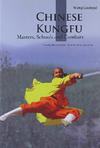中国功夫
出版时间:2010-1 出版社:五洲传播出版社 作者:王广西 页数:124 译者:韩慧枝
内容概要
Wushu, the Chinese martial art form known as kungfu in the West, embodies the national traditional culture in martial art form and also reflects the self-defense and health practices of Chinese people. The core philosophy of Wushu is drawn from the Confucius principle of physical and mental integration combined with neutralization; the Taoist principle of dynamic balance; the Buddhist principle of showing cultural syncretism of Confucianism, Daoism and Buddhism in China; and the Eastern theory, which believes man is an integral part of nature.
作者简介
Wang Guangxi, whose pen name is LuCao, was born in Xixia, Henan province in1941 and died in 2008. He graduated from the Department of Chinese Language and Literature of Henan University. He had servedas a researcher in the Literature Research Institute of He nan Academy of Social Science, a fellow in the Henan Research Institute of Culture and History, standing director of Modern Chinese Literature Research Society and deputy dean of Wushu Culture Research Center, Physical Education Institute, Zhengzhou University. His life was devoted to modern literature and wushu culture research, and his works include Buddhism and Chinese Modern Poetry, Biography of Zuo Zong tang, Kong Fu-Culture of Chinese Wushu Circles Chinese Soldier, Chinese Wushu and Wushu Spirit and Central Plaint Culture. Wushu.
书籍目录
ForewordThe Origins of Martial ArtsPrinciples of WushuSchools of WushuShaolinquan FamilyWudangquan FamilyEmeiquan FamilyNanquan FamilyTaijiquan FamilyXingyiquan FamilyBaguaquan FamilyWeaponsShort WeaponsLong WeaponsHidden Weapons (anqi)Three Stages of Chinese Wushu PracticeCharacteristics of Chinese WushuSystematicStrict OrderPrinciple of GradualnessNurturing Qi and Moral CultivationAestheticsChinese Wushu and Chinese CultureWushu and RegimenWushu and Literatures, Films and TVChinese and Foreign Wushu ExchangeTwo Big Challenges in the Martial HistoryChinese Wushu Going GlobalDevelopment of Modern Chinese WushuModern Wushu Centers (schools)Wushu Education at Colleges and UniversitiesWushu Competitions and Olympic PerformanceEventsFolk Wushu DevelopmentDevelopment TendencyAppendix I: Notices on Wushu ExercisesAppendix Ih Chronological Table of the ChineseDynasties
章节摘录
版权页: 插图: After learning the basic techniques and several set exercises,one can learn Chaiquan to practice several actions,which lays a firm foundation in hand,footwork,eye and body exercises.Simultaneously,one can gather the qi scattered in the body in dantian to eliminate the excess tension and grow strong strength.Once the excess tension is eliminated completely,the body will be full of strong strength,spirit and vitality.The body then becomes strong,and the steps steady.The visible strength has been achieved,while the exercises benefiting the bones are completed.This brings one to reach the level of refining spirit into qi. People who complete the primary stage are usually strong and vigorous,and have sharp eyes.Sometimes,they are hot-blooded,unyielding,impetuous and proud of their martial art techniques.If they pursue further study to enter a senior level such characteristics can be refined. Refining qi into vitality refers to the intermediate stage,where one completes the exercises to benefit the muscles and grow invisible strength.Invisible strength refers to soft strength.However,"soft" in Wushu doesn't mean "weak," but "flexible." The invisible strength integrates soft and strong strengths,which supplement each other.The stage of refining qi into vitality is meant to eliminate strong strength and grow soft strength.This stage is the second period of strength improvement. Refining qi is key to this stage.In fact,one shall learn to gather the qi scattered in the body in dantian during the primary stage of refining the spirit into qi,during which one cannot control the flow of genuine qi(zhenqi).
编辑推荐
《中国功夫(英文版)》由五洲传播出版社出版。
图书封面
评论、评分、阅读与下载
用户评论 (总计1条)
- 书的质量不错,里面还有颜色。是帮朋友买的,就是觉得太薄了~
推荐图书
- 新教材高效学习.八年级物理第一学期
- 2010-2011年高考英语满分作文专辑
- 2012年全国高考满分作文专辑
- 新教材高效学习.九年级语文(全一册)
- 新教材高效学习.六年级数学第一学期
- 单元+月考六年级英语
- 3年级数学下
- 2012年全国中考满分作文专辑
- 神奇的酵素养生法
- 开拓青少年大脑的思维游戏丛书
- 中国少数民族宗教
- 中国少数民族教育
- 中国少数民族体育
- 速学国际音标
- 小学语文课本同步自主阅读
- 仓储管理实务
- 初中英语语法常见错误
- 国家竞争战略
- 现代企业文化100招
- 高中生必做的语法题
- 初中生必做的语法题
- 电工技术基础与技能学习指导和练习
- 2012陈先奎教授考研思想政治系列
- 2012版-陈先奎考研政治系列-《思想政治理论基础过关2000题》
- 执业医师资格考试实践技能图解
